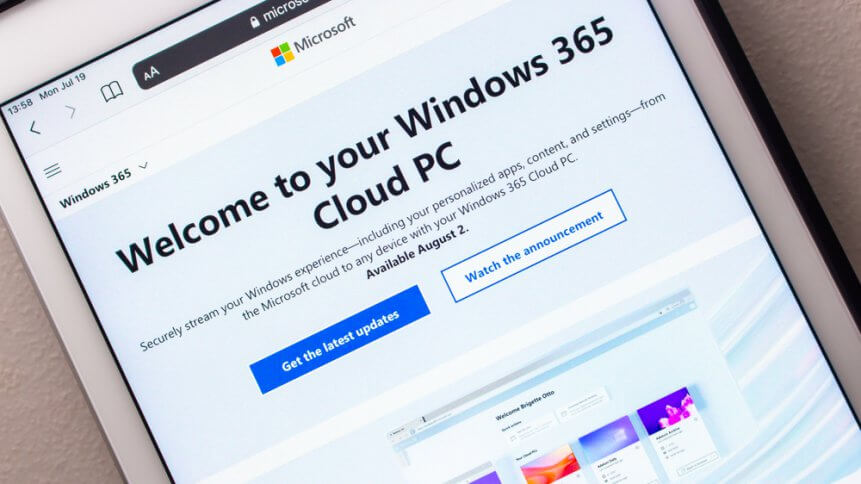Windows 365 — your virtualized mainframe in the cloud?

The concept of a fully virtualized desktop is one that’s so attractive to people (or at least intriguing enough for plenty of them) that Microsoft has been forced to pull the free 60-day trial to its new Windows 365 service.
For those not aware of this latest offering from Redmond, Windows 365 is a virtualized PC running Windows 10 (or Windows 11, later this year) that’s accessed via any internet-connected device. Users pay a monthly fee for access to a dedicated, cloud-based PC with fees pegged to the performance of the remote system. Users can specify up to 8 cores of CPU, 32GB of RAM, and 512GB of storage.
A mid-range offering (2 CPUs, 8GB/128GB) will cost US$41 a month. Given an average three-year lifespan for a Windows PC, that would equate to a total cost of US$1476. For the same price, you could purchase a new Dell XPS 13 laptop running an 11th gen i5 processor, complete with 16GB RAM and a 1TB NVMe drive. Windows 365 is, therefore, not cheap.
But the remote desktop paradigm is not designed to be cheap, necessarily. Two significant advantages for prospective business users are ultimate portability (use the same desktop wherever you happen to be), and security, the latter ever the bugbear to cybersecurity teams.
The pay-as-you-go model might be a more attractive mode of financing users’ operating systems, entered against OPEX rather than CAPEX, especially if purse strings have been tightened and a full hardware refresh across a fleet is coming due. Microsoft has made no bones about the minimum hardware specifications required to run Windows 11, and for many companies keen to stay with the Windows operating environment, that might mean replacing a raft of existing hardware for users without machines capable of UEFI or no/older TPM security chips on their motherboards.
For freelance contractors or gig economy workers, virtualized environments provided by the employing institution also offer a safe bet in ensuring workflow compatibility, software license compliance, and some semblance of security.
Microsoft has offered a less user-friendly Azure Virtual Desktop for some time, of course, with pricing based on consumption. Additionally, there are plenty of virtual desktop providers with facilities running on established software, and many of them are significantly cheaper than the daddy of them all, Microsoft. Outside the cachet of getting one’s virtual OS from its makers, users can expect seamless tie-ins and interoperability with the Microsoft cloud ecosystem. Azure, SharePoint and Microsoft 365 (née Office 365) will all work together nicely, as long as licenses are already in place, or the organization pays extra on its monthly stipend.
Windows 365 Business subscription will probably suit smaller companies (fewer than 300 seats), while larger enterprises will have license agreements in place that can be leveraged, discounting Windows 365 Enterprise. Holders of a Windows 10 Pro license on their primary workstation receive a small discount, additionally.
Microsoft has been fastidiously steering towards a cloudy future for some years now, and its initial VDI offering seems destined to keep that destination on course. The Windows 365 virtual desktop comes from the same stable of thought that birthed Chrome OS, designed to shift compute workload from the local to the remote server. Google’s lightweight operating system has found most traction in education, not the business sector, thanks to the low hardware requirements needed to run the OS (a Linux desktop) keeping costs low for cash-strapped institutions. Despite Microsoft’s hyperbolic assertion that “Microsoft unveils Windows 365 — ushering in a new category of computing”, Redmond is on well-trodden ground.
Ushering in a new category of trial
Introducing Windows 365.
The first Cloud PC for every organization on the planet. https://t.co/OdJEr3DApx #Windows365 pic.twitter.com/8poKUWqZPP
— Microsoft 365 (@Microsoft365) July 14, 2021
Companies interested in trying the service are all out of luck — the 60-days free trial has been closed because the mighty Azure resources Microsoft assigned to the rollout have been swamped by interested parties, although companies can still access the service by paying. If the sudden closure of the trial scheme is an indication of eventual popularity of Windows 365, then Microsoft may have found a winner.
The best experience for Windows 365 users is via that old stalwart of remote access, RDC, clients of which are available for Windows, Mac, iOS and Android — although if users find themselves without the ability to install a local app, the VDI ecosystem can be accessed through a web browser. Presumably, Edge will be the favored option.
YOU MIGHT LIKE

Virtualizing out of monthly Patch Tuesday problems
Enterprises with Active Directory schema, Exchange-based services, and SharePoint stores will find Windows 365 plugs straight in natively, and the web interface allows a broader clutch of users to get immediate, albeit somewhat limited, access into the Microsoft stack. That means users that only need occasional Windows usage will be able to play natively in Exchange/AD environments. However, as anyone who has ever tried to use Microsoft-flavored “cross-platform” offerings from outside the tightly-licensed walled garden will tell you, there is always an incentive to go “full-Microsoft” thanks to various glitches and version incompatibilities.
Although early days for Windows 365, the way forward for Microsoft has long been signaled by cloud-based applications on the desktop like the Microsoft 365 suite. The last significant install onto many clients (in pure GB terms) remains the Windows operating system. By abstracting that away into the cloud, desktop IT begins a return to the mainframe (cloud) – thin client (RDC) paradigm that was around well before the arrival of the desktop PC in the 1980s.
With Microsoft 365 and Windows 365, the work PC might soon just be a conduit to the cloud, a vision that Google has been promoting for a while for its own reasons. Microsoft is poised to extend the model into the workplace, replacing Windows 10 or 11 license fees with cloud service levies, while upsetting the Google Docs applecart into the bargain. As for Chrome OS, that’s for the children to play with.









